- Table of Content
- 1.Reminder - Ten...
- 2.X-class flares...
- 3.SWx Jobs at RO...
- 4.Review of sola...
- 5.Review of geom...
- 6.Noticeable Sol...
- 7.The Internatio...
- 8.PROBA2 Observa...
- 9.Geomagnetic Ob...
- 10.The SIDC Space...
- 11.Time for actio...
2. X-class flares are back!
3. SWx Jobs at ROB
4. Review of solar activity
5. Review of geomagnetic activity
6. Noticeable Solar Events (2 Jan 2023 - 8 Jan 2023)
7. The International Sunspot Index by SILSO
8. PROBA2 Observations (2 Jan 2023 - 8 Jan 2023)
9. Geomagnetic Observations in Belgium (2 Jan 2023 - 8 Jan 2023)
10. The SIDC Space Weather Briefing
11. Time for action!
Reminder - Tenth call for PROBA2 Guest Investigators
The tenth call for PROBA2 Guest Investigators is open. Selected proposers will be invited to spend a few weeks with the SWAP and LYRA PI teams to obtain expert knowledge on the instruments. Find more details on https://proba2.sidc.be/TenthGICall.
Submission deadline: 31 January 2023.

X-class flares are back!
On 6 January, NOAA 3182 produced an X1.2 flare peaking at 00:57 UTC. This was the first X-class event since 2 October last year (see this STCE newsitem at https://www.stce.be/news/607/welcome.html ). To make up for this drought, a second X-class flare was produced, this time by NOAA 3184 on 9 January. This X1.9 flare peaked at 18:50 UTC. The eruptions were discussed in 2 STCE newsflashes, respectively at https://www.stce.be/news/620/welcome.html (X1.2) and at https://www.stce.be/news/621/welcome.html (X1.9), which contain some movies of the eruptions. Underneath a side-by-side comparison of the two flares in extreme ultraviolet (EUV) as observed by SDO/AIA 131 (https://sdo.gsfc.nasa.gov/data/aiahmi/ ). The blooming and diffraction patterns in the EUV images are image artefacts, not related to the flare - See this STCE newsitem https://www.stce.be/news/499/welcome.html for more info.
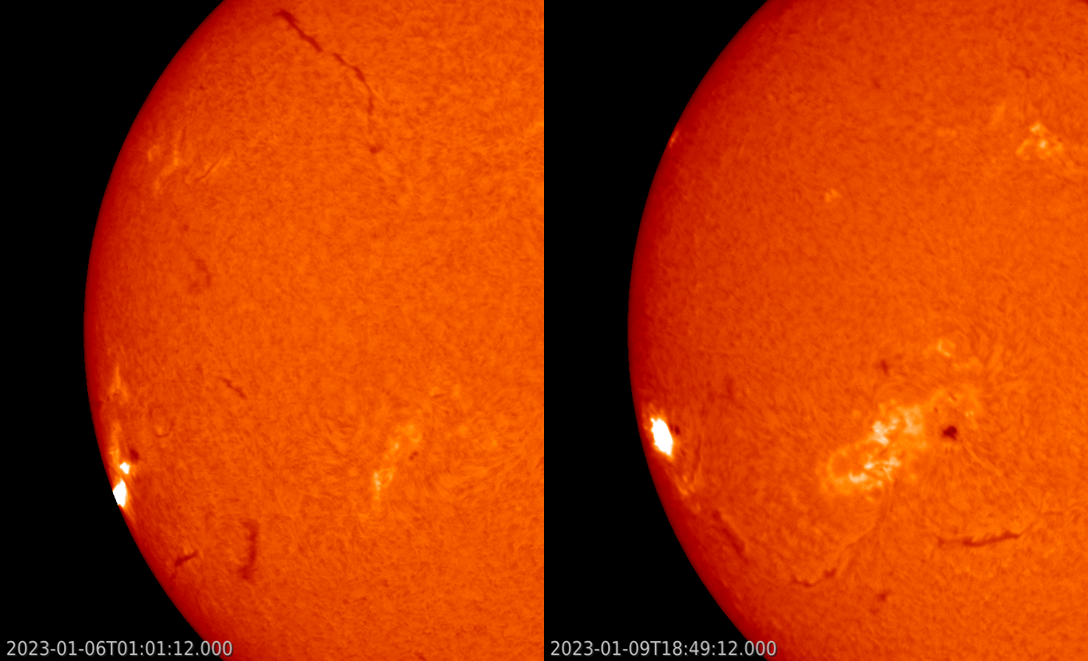
The two flaring events were remarkably similar. Both occurred when the source regions were still very close to the southeast solar limb. The events had similar durations in soft x-rays (SXR) (resp. 24 and 20 minutes), and similar intensities both in SXR (resp. X1.2 and X1.9) and in H-alpha (optical class resp. 2B and 3B). The STCE's SWx Classification page at https://www.stce.be/educational/classification contains more information on these flare classifications. The H-alpha images underneath are from the GONG H-alpha network (https://gong.nso.edu/ ) and show the two flares near their respective SXR peak maximum.
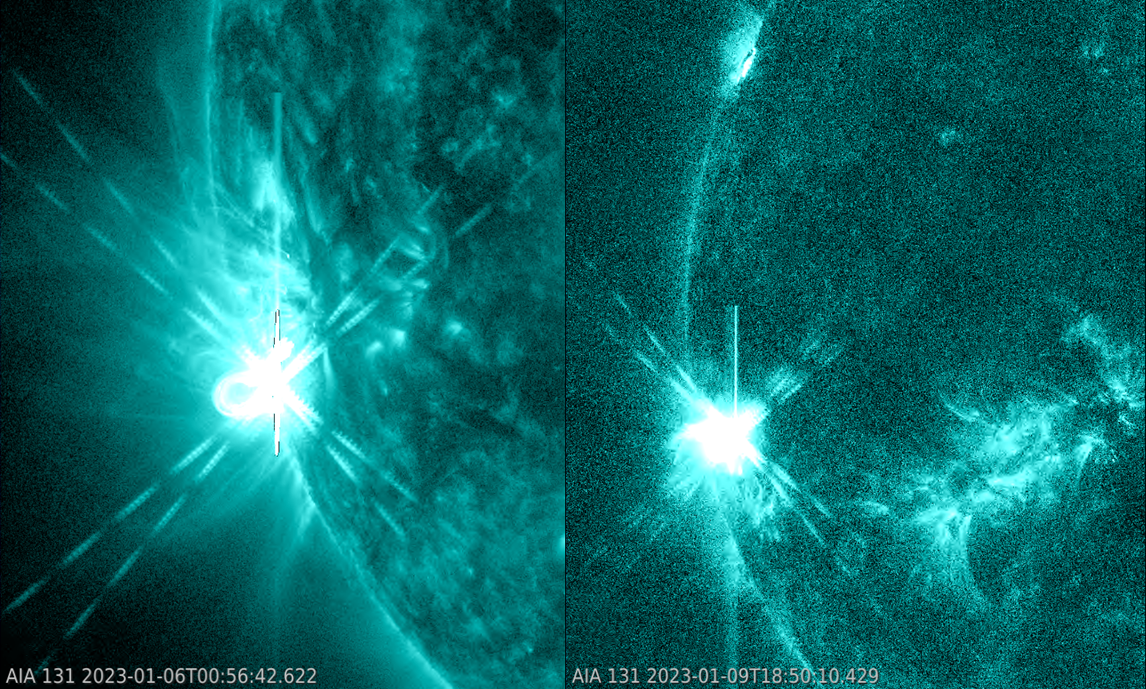
Radio observations indicated that a Tenflare, i.e. a doubling (or more) of the radio emission at 2800 MHz compared to pre-flare values, was associated with both eruptions, with the solar radio flux up resp. 420 and 230 sfu. Enhanced radio emissions were also observed at other frequencies such as 5 and 8.8 GHz by the Radio Solar Telescope Network (https://www.sws.bom.gov.au/World_Data_Centre/2/8/9 ) from the United States Air Force. The radio spectrograms showed the absence of a Type II burst (https://www.stce.be/educational/classification#radio ) after both flaring events. This would otherwise have been suggestive of an associated coronal mass ejection (CME), but coronagraphic images have meanwhile confirmed the radio observations and ruled out the presence of a CME.
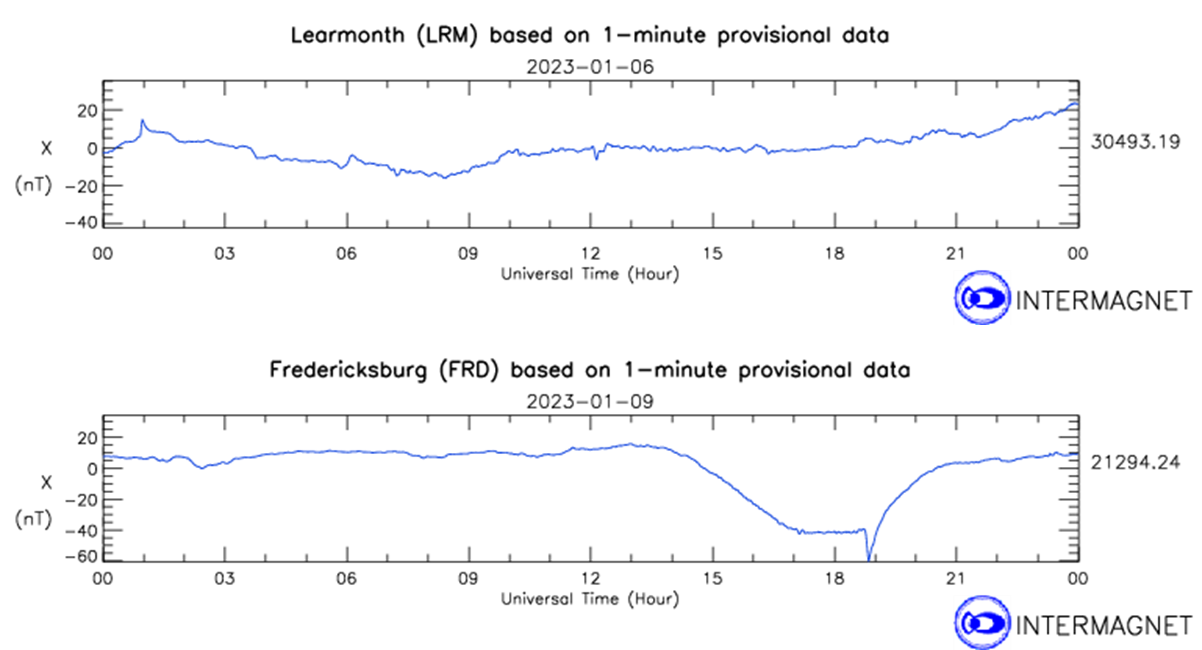
The space weather effects were rather limited. The intense x-ray and EUV emissions disturbed the ionosphere, and High Frequency (HF) communications were degraded mainly over the Pacific and resp. Australia/New Zealand and Latin America. PECASUS (https://pecasus.eu/ ) issued a HF COM advisory for the international civil aviation in both cases. The enhancement of the ionosphere created also a sudden change in the Earth's magnetic field, called a "solar flare effect" or also known as "magnetic crochet" due to the peculiar shape it leaves in a magnetogram. A small sudden "spike" can be seen in the above magnetograms (X-component) from Learmonth (6 January) and Fredericksburg (9 January) around the time of the flare's SXR peak (graphs obtained via Intermagnet (https://www.intermagnet.org/data-donnee/dataplot-eng.php ). The change in the magnetic field strength was up to about 10 to 20 nT for both flaring events, depending on the location (sunlit side) of the magnetometer station. For very strong flares such as the two main Halloween flares in 2003 and the Carrington event in 1859, these values can be well over 100 nT, putting things a bit in perspective. Magnetic crochets may influence systems and operations which are sensitive to the magnetic field amplitude, such as magnetic anomaly surveys and directional wellbore drilling.
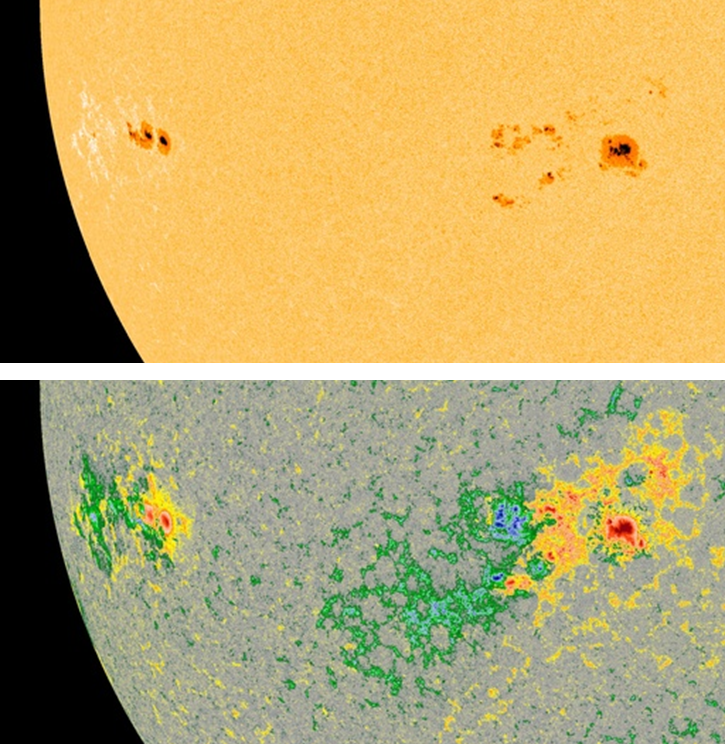
Differences between the two X-class flares were few. The outlook of the source region is one of them. The 6 January event seems to have been caused in the trailing portion of a large sunspot group with widely scattered sunspots, possibly a co-habitation of 2 or more closely spaced sunspot regions. On the other hand, the source of the 9 January flare was a much smaller and more compact sunspot group containing opposite magnetic polarity spots in its main portion. The above SDO/HMI white light image (upper) and magnetogram (lower image) show the difference between the two regions on 10 January around noon. Another difference is a small enhancement in the greater than 10 MeV proton flux that was recorded shortly after midnight on 10 January, so about 5 hours after the X1.9 peak, as shown in the plot underneath (GOES - https://www.swpc.noaa.gov/products/goes-proton-flux ). The maximum flux was about 1 pfu (https://www.stce.be/educational/acronym ), so well below the alert threshold of 10 pfu. Such an enhancement was not observed following the first X-class event. It remains to be seen if there is a connection between the X-class flare from NOAA 3184 and the proton enhancement, as no obvious CME was associated with the X1.9 flare, and such small enhancements may have other causes. Nonetheless, if the connection is there, then there might be an increasing chance on a proton event if NOAA 3184 remains flare-active as it moves further over the solar disk, thus gradually providing a better magnetic connection with the earth-environment for those energetic particles.
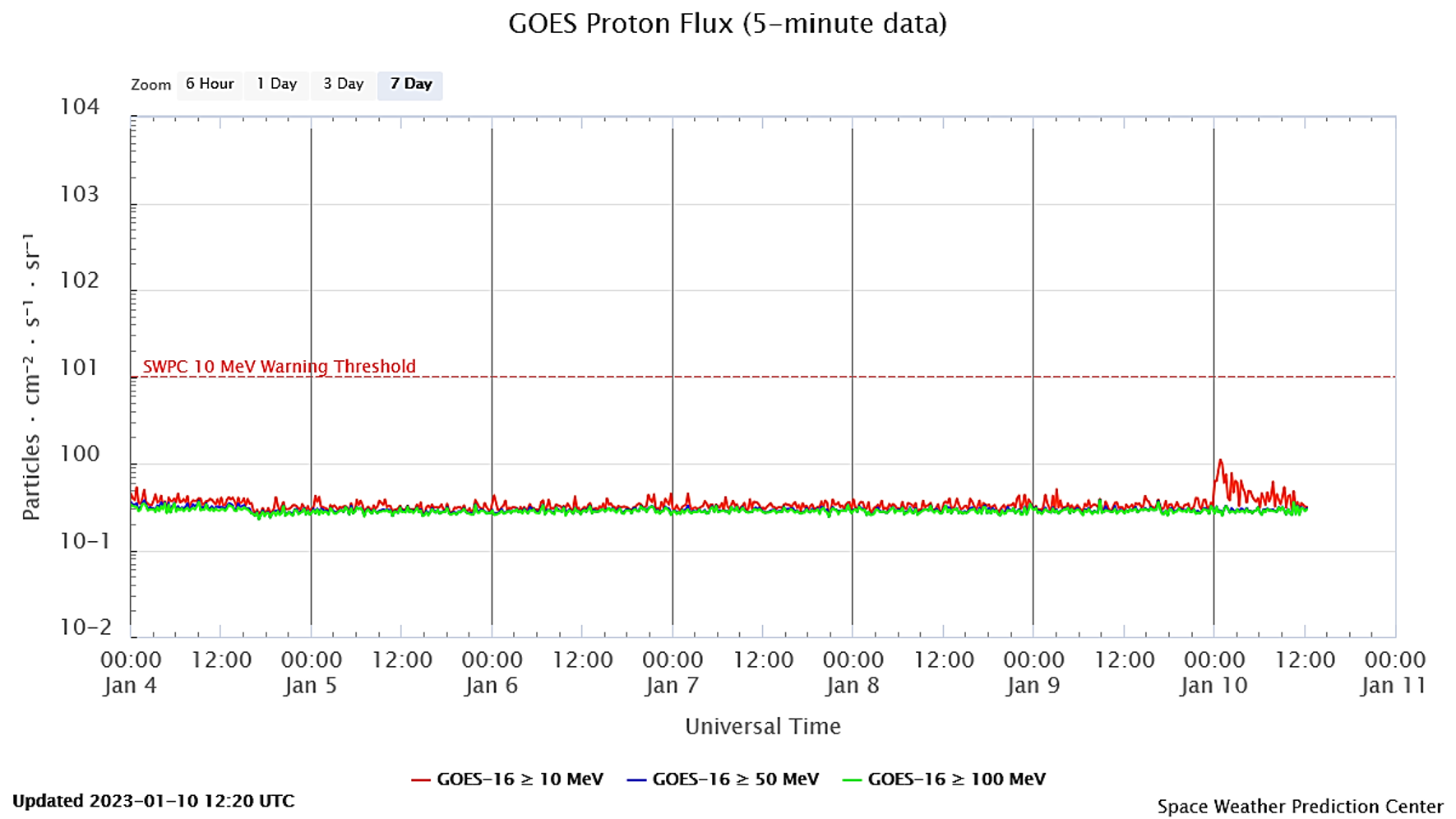
SWx Jobs at ROB
Who are we?
The job openings are at the SIDC (Solar Influences Data Analysis Center, https://www.sidc.be) at the Royal Observatory of Belgium (https://www.astro.oma.be). The SIDC is building and running a leading space weather forecast center at international level providing services to citizens, industry and government by means of alerts and predictions with the support of ESA (European Space Agency Space Safety Program, https://swe.ssa.esa.int) and the STCE (Solar-Terrestrial Centre of Excellence, https://www.stce.be). In 2018, ICAO (International Civil Aviation Organisation) selected the PECASUS consortium (https://pecasus.eu) of which the space weather center is part, to deliver 24h/7d space weather services to the civil aviation actors worldwide.
To assure the successful continuation of our 24h/7d operations in this competitive international context, the Royal Observatory of Belgium seeks several collaborators for the further development and support of its space weather services. The offered positions are immediately available for one year which after mutual satisfaction will be extended by 2 years, and eventually by a contract of undetermined duration.
Practical
A CV and accompanying motivation letter must be sent as soon as possible to jesse.andries at oma.be, judith.depatoul at oma.be and dir-rob at oma.be with clear indication on the selected position(s).
Applications are welcome until February 19, 2023.
Complete information and instructions: https://www.astro.oma.be/en/information/jobs and https://www.astro.oma.be/common/pdf/jobs/202205-SpaceWeatherCollaborator_EN_final.pdf
Candidates can contact Dr. Jesse Andries or Dr. Judith de Patoul for additional information.
Review of solar activity
Flares
Solar activity was low for the first half of the week increasing to high levels on January 06 and then was at moderate on January 07 and 08. There were eight Active Regions (AR) on the disk over the course of the week. From January 05, the increased flaring activity originated from NOAA AR 3182, including an X1.2 flare onJanuary 06. This occurred just as the active region had rotated onto the solar disk near the south east limb. By the end of the week another active region, NOAA AR 3182, was also rotating onto the disk and was responsible for multiple low level M-class flares.
Coronal Mass Ejections
There were no Earth-directed Coronal Mass Ejections (CMEs) detected in the available coronagraph imagery. A partial halo CME was detected on January 03 from 06:48 in LASCO C2 data. This CME originated from a back sided event, beyond the south east limb, and was therefore not Earth-directed.
Energetic Particles near Earth
The greater than 10 MeV proton flux was at nominal levels. The greater than 2 MeV electron flux exceeded the 1000 pfu alert threshold on multiple occasions between January 01 and January 03, in response to the earlier high speed stream. The 24h electron fluence reached moderate levels on these days before reducing to nominal levels from January 04.
Review of geomagnetic activity
The Solar Wind near Earth
At the start of the week, the solar wind conditions reflected the waning influence of a high speed stream, with the solar wind speed decreasing from values around 550 km/s.
From January 04, the arrival of an ICME is reflected in the solar wind data. The total magnetic field reached a maximum value of 21 nT, with a minimum Bz of -12 nT on January 04. The solar wind speed associated with the ICME was around 450 km/s.
Combined with the ICME arrival, the solar wind data showed the orientation of the magnetic field switch from the positive to the negative sector from 18:00 UTC January 04 (field directed towards from the Sun), due to the expected influence of the solar wind associated with the negative polarity coronal hole which crossed the central meridian on January 01. This caused a slight enhancement in the solar wind speed above 500 km/s on January 06.
The Geomagnetic Field
Geomagnetic conditions were unsettled to active at the start of the week, increasing to minor storm conditions (NOAA Kp=5) in response to the enhanced IMF and strong negative Bz associated with the arrival of the ICME on January 04. For the remainder of the week the geomagnetic conditions were quiet to unsettled.
Noticeable Solar Events (2 Jan 2023 - 8 Jan 2023)
| DAY | BEGIN | MAX | END | LOC | XRAY | OP | 10CM | TYPE | Cat | NOAA |
| 06 | 0043 | 0057 | 0107 | S18E68 | X1.2 | 2B | 420 | III/2 | 38 | 3182 |
| 07 | 0040 | 0052 | 0102 | S18E56 | M1.6 | SF | VI/2 | 38 | 3182 | |
| 08 | 0839 | 0854 | 0906 | M1.2 | VI/2 | 3184 | ||||
| 08 | 0915 | 0948 | 1014 | M1.4 | VI/3 | 3184 | ||||
| 08 | 1451 | 1507 | 1521 | M1.4 | 3184 | |||||
| 08 | 1902 | 1911 | 1919 | S15E86 | M1.0 | SF | VI/2 | 3184 |
| LOC: approximate heliographic location | TYPE: radio burst type |
| XRAY: X-ray flare class | Cat: Catania sunspot group number |
| OP: optical flare class | NOAA: NOAA active region number |
| 10CM: peak 10 cm radio flux |
The International Sunspot Index by SILSO

The daily Estimated International Sunspot Number (EISN, red curve with shaded error) derived by a simplified method from real-time data from the worldwide SILSO network. It extends the official Sunspot Number from the full processing of the preceding month (green line), a few days more than one solar rotation. The horizontal blue line shows the current monthly average. The yellow dots give the number of stations that provided valid data. Valid data are used to calculate the EISN. The triangle gives the number of stations providing data. When a triangle and a yellow dot coincide, it means that all the data is used to calculate the EISN of that day.
PROBA2 Observations (2 Jan 2023 - 8 Jan 2023)
Solar Activity
Solar flare activity fluctuated from low to high during the week.
In order to view the activity of this week in more detail, we suggest to go to the following website from which all the daily (normal and difference) movies can be accessed: https://proba2.oma.be/ssa
This page also lists the recorded flaring events.
A weekly overview movie can be found here (SWAP week 667).
https://proba2.sidc.be/swap/data/mpg/movies/weekly_movies/weekly_movie_2023_01_02.mp4
Details about some of this week's events can be found further below.
Friday Jan 06
If any of the linked movies are unavailable they can be found in the P2SC movie repository here https://proba2.sidc.be/swap/data/mpg/movies/
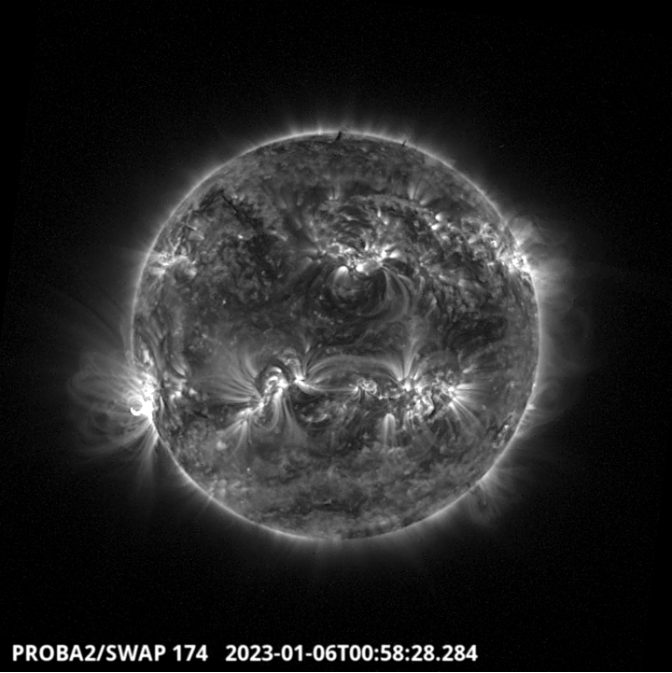
The largest flare of the week, a X1.2, has been produced by the active region NOAA 3182 located on the South-East limb of the solar disk around 00:58 UT - SWAP image. Find a movie of the events here
(SWAP movie) https://proba2.sidc.be/swap/data/mpg/movies/20230106_swap_movie.mp4
Geomagnetic Observations in Belgium (2 Jan 2023 - 8 Jan 2023)

Local K-type magnetic activity index for Belgium based on data from Dourbes (DOU) and Manhay (MAB). Comparing the data from both measurement stations allows to reliably remove outliers from the magnetic data. At the same time the operational service availability is improved: whenever data from one observatory is not available, the single-station index obtained from the other can be used as a fallback system.
Both the two-station index and the single station indices are available here: http://ionosphere.meteo.be/geomagnetism/K_BEL/
The SIDC Space Weather Briefing
The Space Weather Briefing presented by the forecaster on duty from to . It reflects in images and graphs what is written in the Solar and Geomagnetic Activity report: https://www.stce.be/briefings/20230109_SWbriefing.pdf

If you need to access the movies, contact us: stce_coordination at stce.be
Time for action!
Check out our activity calendar: activities and encounters with the Sun-Space-Earth system and Space Weather as the main theme. We provide occasions to get submerged in our world through educational, informative and instructive activities.
If you want your event in our calendar, contact us: stce_coordination at stce.be
* January 16, Seminar: Realistic Ionosphere (RION), data fusion project of GIRO and GNSS, STCE
* January 18, Seminar: How do black holes shine - multiwavelength emission in the high-energy Universe, KU Leuven/CmPA
* January 19: Sun, Space Weather and satellites - Workshops in primary school De Oogappel, Ghent
* January 27, POSTPONED Seminar: Opportunities of Wikipedia and related applications for science, BIRA-IASB
* January 30, 31, February 2, 3, Space Weather Introductory Course - online, by the STCE, zoom
* March 14, PITHIA-NRF High Profile Meeting, Brussels, Belgium
* March 15, PITHIA-NRF Innovation Day, Brussels, Belgium
* March 16, PITHIA-NRF Training for Partners, Brussels, Belgium
* March 17, PITHIA-NRF Workshop for Optimization of Observational Strategies, Brussels, Belgium
* March 27-29, Space Weather Introductory Course - onsite, by the STCE, Brussels, Belgium
* May 22-24, Space Weather Introductory Course - onsite, by the STCE, Brussels, Belgium
* May 29 - June 1, PITHIA-NRF Training School, Rome, Italy
Check: https://www.stce.be/calendar
